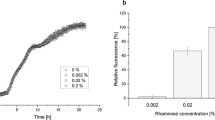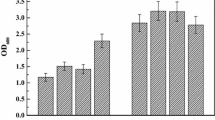Abstract
Shewanella oneidensis MR-1 is one of the most well-known metal-reducing bacteria and it has been extensively studied for microbial fuel cell and bioremediation aspects. In this study, we have examined S. oneidensis MR-1 as an isobutanol-producing host by assessing three key factors such as isobutanol synthetic genes, carbon sources, and electron supply systems. Heterologous Ehrlich pathway genes, kivD encoding ketoisovalerate decarboxylase and adh encoding alcohol dehydrogenase, were constructed in S. oneidensis MR-1. Among the composition of carbon sources examined, 2 % of N-acetylglucosamine, 1.5 % of pyruvate and 2 % of lactate were found to be the most optimal nutrients and resulted in 10.3 mg/L of isobutanol production with 48 h of microaerobic incubation. Finally, the effects of metal ions (electron acceptor) and direct electron transfer systems on isobutanol production were investigated, and Fe2+ ions increased the isobutanol production up to 35 %. Interestingly, deletion of mtrA and mtrB, genes responsible for membrane transport systems, did not have significant impact on isobutanol production. Finally, we applied engineered S. oneidensis to a bioelectrical reactor system to investigate the effect of a direct electron supply system on isobutanol production, and it resulted in an increased growth and isobutanol production (up to 19.3 mg/L). This report showed the feasibility of S. oneidensis MR-1 as a genetic host to produce valuable biochemicals and combine an electron-supplying system with biotechnological applications.






Similar content being viewed by others
References
Lovley DR (2006) Bug juice: harvesting electricity with microorganisms. Nat Rev Microbiol 4:497–508
Ringeisen BR, Henderson E, Wu PK, Pietron J, Ray R, Little B, Biffinger JC, Jones-Meehan JM (2006) High power density from a miniature microbial fuel cell using Shewanella oneidensis DSP10. Environ Sci Technol 40:2629–2634
Du Z, Li H, Gu T (2007) A state of the art review on microbial fuel cells: a promising technology for wastewater treatment and bioenergy. Biotechnol Adv 25:464–482
Tiedje JM (2002) Shewanella–the environmentally versatile genome. Nat Biotechnol 20:1093–1094
Ghangrekar MM, Shinde VB (2007) Performance of membrane-less microbial fuel cell treating wastewater and effect of electrode distance and area on electricity production. Bioresour Technol 98:2879–2885
Cooper DC, Picardal F, Rivera J, Talbot C (2000) Zinc immobilization and magnetite formation via ferric oxide reduction by Shewanella putrefaciens 200. Environ Sci Technol 34:100–106
Gorby YA, Yanina S, McLean JS, Rosso KM, Moyles D, Dohnalkova A, Beveridge TJ, Chang IS, Kim BH, Kim KS, Culley DE, Reed SB, Romine MF, Saffarini DA, Hill EA, Shi L, Elias DA, Kennedy DW, Pinchuk G, Watanabe K, Ishii S, Logan B, Nealson KH, Fredrickson JK (2006) Electrically conductive bacterial nanowires produced by Shewanella oneidensis strain MR-1 and other microorganisms. Proc Natl Acad Sci USA 103:11358–11363
Meshulam-Simon G, Behrens S, Choo AD, Spormann AM (2007) Hydrogen metabolism in Shewanella oneidensis MR-1. Appl Environ Microb 73:1153–1165
Hartshorne RS, Jepson BN, Clarke TA, Field SJ, Fredrickson J, Zachara J, Shi L, Butt JN, Richardson DJ (2007) Characterization of Shewanella oneidensis MtrC: a cell-surface decaheme cytochrome involved in respiratory electron transport to extracellular electron acceptors. J Biol Inorg Chem 12:1083–1094
Hartshorne RS, Reardon CL, Ross D, Nuester J, Clarke TA, Gates AJ, Mills PC, Fredrickson JK, Zachara JM, Shi L, Beliaev AS, Marshall MJ, Tien M, Brantley S, Butt JN, Richardson DJ (2009) Characterization of an electron conduit between bacteria and the extracellular environment. Proc Natl Acad Sci USA 106:22169–22174
Pitts KE, Dobbin PS, Reyes-Ramirez F, Thomson AJ, Richardson DJ, Seward HE (2003) Characterization of the Shewanella oneidensis MR-1 decaheme cytochrome MtrA. J Biol Chem 278:27758–27765
Jensen HM, Albers AE, Malley KR, Londer YY, Cohen BE, Helms BA, Weigele P, Groves JT, Ajo-Franklin CM (2010) Engineering of a synthetic electron conduit in living cells. Proc Natl Acad Sci USA 107:19213–19218
Mitchell AC, Peterson L, Reardon CL, Reed SB, Culley DE, Romine MR, Geesey GG (2012) Role of outer membrane c-type cytochromes MtrC and OmcA in Shewanella oneidensis MR-1 cell production, accumulation, and detachment during respiration on hematite. Geobiology 10:355–370
Okamoto A, Hashimoto K, Nealson KH, Nakamura R (2013) Rate enhancement of bacterial extracellular electron transport involves bound flavin semiquinones. Proc Natl Acad Sci USA 110:7856–7861
Schuetz B, Schicklberger M, Kuermann J, Spormann AM, Gescher J (2009) Periplasmic electron transfer via the c-type cytochromes MtrA and FccA of Shewanella oneidensis MR-1. Appl Environ Microb 75:7789–7796
Madje K, Schmolzer K, Nidetzky B, Kratzer R (2012) Host cell and expression engineering for development of an E. coli ketoreductase catalyst: enhancement of formate dehydrogenase activity for regeneration of NADH. Microb Cell Fact 11:7
Saint-Amans S, Girbal L, Andrade J, Ahrens K, Soucaille P (2001) Regulation of carbon and electron flow in Clostridium butyricum VPI 3266 grown on glucose-glycerol mixtures. J Bacteriol 183:1748–1754
Pinchuk GE, Geydebrekht OV, Hill EA, Reed JL, Konopka AE, Beliaev AS, Fredrickson JK (2011) Pyruvate and lactate metabolism by Shewanella oneidensis MR-1 under fermentation, oxygen limitation, and fumarate respiration conditions. Appl Environ Microb 77:8234–8240
Thormann KM, Saville RM, Shukla S, Spormann AM (2005) Induction of rapid detachment in Shewanella oneidensis MR-1 biofilms. J Bacteriol 187:1014–1021
Blombach B, Riester T, Wieschalka S, Ziert C, Youn JW, Wendisch VF, Eikmanns BJ (2011) Corynebacterium glutamicum tailored for efficient isobutanol production. Appl Environ Microb 77:3300–3310
Connor MR, Atsumi S (2010) Synthetic biology guides biofuel production. J Biomed Biotechnol
Yan Y, Liao J (2009) Engineering metabolic systems for production of advanced fuels. J Ind Microbiol Biot 36:471–479
Lu JN, Brigham CJ, Gai CS, Sinskey AJ (2012) Studies on the production of branched-chain alcohols in engineered Ralstonia eutropha. Appl Microbiol Biot 96:283–297
Slater S, Houmiel KL, Tran M, Mitsky TA, Taylor NB, Padgette SR, Gruys KJ (1998) Multiple beta-ketothiolases mediate poly(beta-hydroxyalkanoate) copolymer synthesis in Ralstonia eutropha. J Bacteriol 180:1979–1987
Coursolle D, Baron DB, Bond DR, Gralnick JA (2010) The Mtr respiratory pathway is essential for reducing flavins and electrodes in Shewanella oneidensis. J Bacteriol 192:467–474
Xiao X, Xu CC, Wu YM, Cai PJ, Li WW, Du DL, Yu HQ (2012) Biodecolorization of naphthol Green B dye by Shewanella oneidensis MR-1 under anaerobic conditions. Bioresour Technol 110:86–90
Choi O, Um Y, Sang BI (2012) Butyrate production enhancement by Clostridium tyrobutyricum using electron mediators and a cathodic electron donor. Biotechnol Bioeng 109:2494–2502
Chen X, Nielsen KF, Borodina I, Kielland-Brandt MC, Karhumaa K (2011) Increased isobutanol production in Saccharomyces cerevisiae by overexpression of genes in valine metabolism. Biotechnol Biofuels 4:21
Fredrickson JK, Zachara JM, Kennedy DW, Liu CX, Duff MC, Hunter DB, Dohnalkova A (2002) Influence of Mn oxides on the reduction of uranium(VI) by the metal-reducing bacterium Shewanella putrefaciens. Geochim Cosmochim Ac 66:3247–3262
Liu C, Gorby YA, Zachara JM, Fredrickson JK, Brown CF (2002) Reduction kinetics of Fe(III), Co(III), U(VI), Cr(VI), and Tc(VII) in cultures of dissimilatory metal-reducing bacteria. Biotechnol Bioeng 80:637–649
Shi A, Zhu X, Lu J, Zhang X, Ma Y (2013) Activating transhydrogenase and NAD kinase in combination for improving isobutanol prodution. Metab Eng 16:1–10
Reimann A, Biebl H, Deckwer WD (1996) Influence of iron, phosphate and methyl viologen on glycerol fermentation of Clostridium butyricum. Appl Microbiol Biot 50:47–50
Kovach, ME, Elzer PH, Hill DS, Robertson GT, Farris MA, Roop RM, Peterson KM (1995) Four new derivatives of the broad-host-range cloning vector pBBR1MCS, carrying different antibiotic-resistance cassettes. Gene 166:175–176
Acknowledgments
We thanks to Prof. Gralnick, Jeffrey A. at BioTechnology Institute and Department of Microbiology, University of Minnesota kindly giving us ΔmtrA and ΔmtrB strains for our study, and Prof. Sinskey at Department of Biology, Massachusetts Institute of Technology for pJL23 plasmid. This work was supported by the R&D Program of MOTIE/KEIT (10048350) and the National Research Foundation of Korea (NRF) (NRF-2013R1A1A2A10004690), (NRF-2015M1A5A1037196). The work was also supported by the Energy Efficiency & Resources of the Korea Institute of Energy Technology Evaluation and Planning (KETEP) grant funded by the Korea Government Ministry of Trade, Industry and Energy (20133030000300) and the Bio & Medical Technology Development Program of the NRF funded by the Korean government, MISP (2015M3A9B8031831).
Author information
Authors and Affiliations
Corresponding author
Electronic supplementary material
Below is the link to the electronic supplementary material.
Rights and permissions
About this article
Cite this article
Jeon, JM., Park, H., Seo, HM. et al. Isobutanol production from an engineered Shewanella oneidensis MR-1. Bioprocess Biosyst Eng 38, 2147–2154 (2015). https://doi.org/10.1007/s00449-015-1454-z
Received:
Accepted:
Published:
Issue Date:
DOI: https://doi.org/10.1007/s00449-015-1454-z




